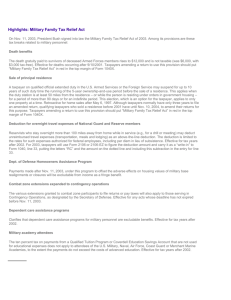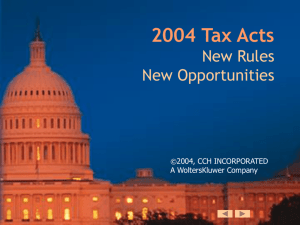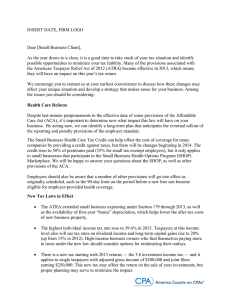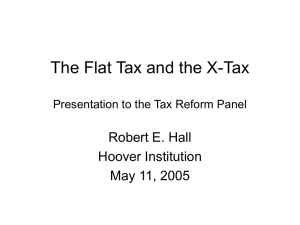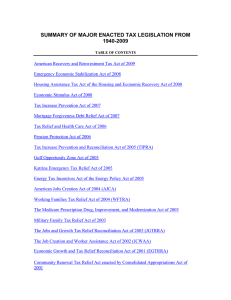AG-ECO NEWS Jose G. Peña
advertisement
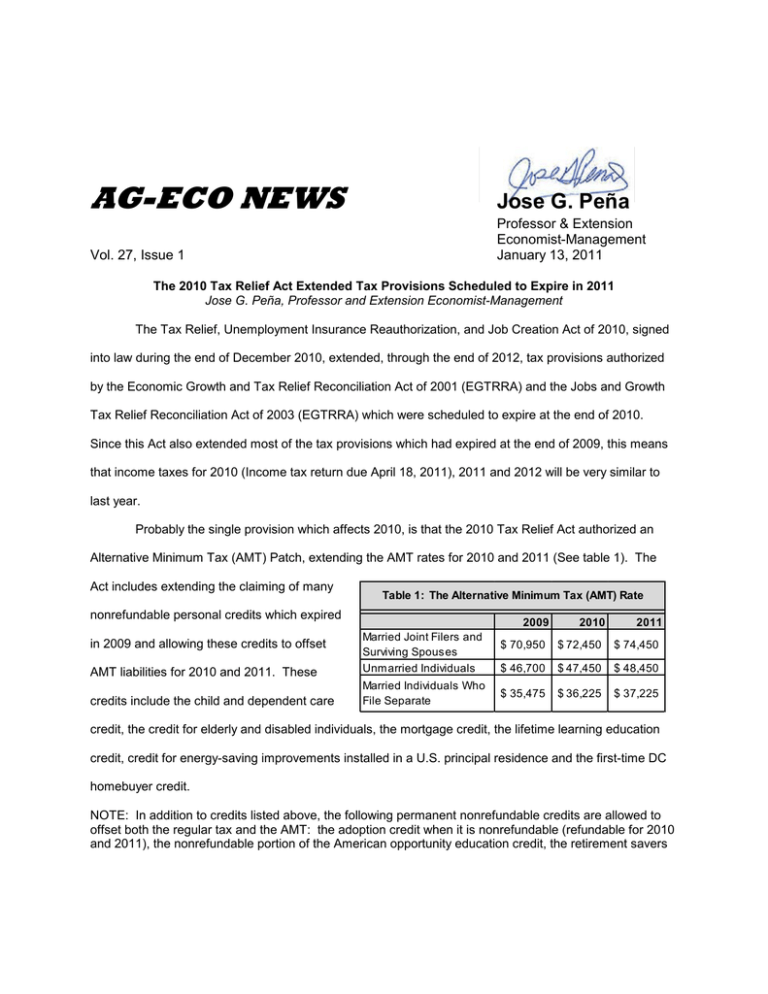
AG-ECO NEWS Jose G. Peña Vol. 27, Issue 1 Professor & Extension Economist-Management January 13, 2011 The 2010 Tax Relief Act Extended Tax Provisions Scheduled to Expire in 2011 Jose G. Peña, Professor and Extension Economist-Management The Tax Relief, Unemployment Insurance Reauthorization, and Job Creation Act of 2010, signed into law during the end of December 2010, extended, through the end of 2012, tax provisions authorized by the Economic Growth and Tax Relief Reconciliation Act of 2001 (EGTRRA) and the Jobs and Growth Tax Relief Reconciliation Act of 2003 (EGTRRA) which were scheduled to expire at the end of 2010. Since this Act also extended most of the tax provisions which had expired at the end of 2009, this means that income taxes for 2010 (Income tax return due April 18, 2011), 2011 and 2012 will be very similar to last year. Probably the single provision which affects 2010, is that the 2010 Tax Relief Act authorized an Alternative Minimum Tax (AMT) Patch, extending the AMT rates for 2010 and 2011 (See table 1). The Act includes extending the claiming of many Table 1: The Alternative Minimum Tax (AMT) Rate nonrefundable personal credits which expired 2009 AMT liabilities for 2010 and 2011. These Married Joint Filers and Surviving Spouses Unmarried Individuals credits include the child and dependent care Married Individuals Who File Separate in 2009 and allowing these credits to offset 2010 2011 $ 70,950 $ 72,450 $ 74,450 $ 46,700 $ 47,450 $ 48,450 $ 35,475 $ 36,225 $ 37,225 credit, the credit for elderly and disabled individuals, the mortgage credit, the lifetime learning education credit, credit for energy-saving improvements installed in a U.S. principal residence and the first-time DC homebuyer credit. NOTE: In addition to credits listed above, the following permanent nonrefundable credits are allowed to offset both the regular tax and the AMT: the adoption credit when it is nonrefundable (refundable for 2010 and 2011), the nonrefundable portion of the American opportunity education credit, the retirement savers credit, the residential energy efficient property (REEP) credit, the nonbusiness portions of the two plug-in electric vehicle credits and the nonbusiness portion of the alternative motor vehicle credit. The following are some of the many provisions extended through 2012 by the Act: NOTE: There are many provisions, too numerous to list here, which were rolled over by this Act. A summary statement as to what to expect would indicate that income taxes for 2010, 2011 and 2012 will be very similar to 2009. • The 10%, 15, 25%, 28%, 33%, and 35% federal income tax rates on ordinary income. • The 0% (for taxpayers below the 25% bracket) and 15% (for those above the 25% bracket) federal income tax rates on most long-term capital gains and dividends. • Qualified dividends are treated as investment income for purposes of the investment interest expense limitation. • The Marriage Penalty Relief rates, i.e., taxpayers filing jointly are taxed at the same rate as single filers. • The personal exemption and itemized deduction phase out, i.e., higher income taxpayers can claim a personal exemption and itemized deductions (above the standard deduction) without phasing out these amounts above a certain taxpayer’s AGI amount. • Taxpayers age 70.5 or over may make annual tax-free gifts directly to authorized charities of IRA distributions of up to $100,000. • Option to deduct state and local sales taxes (for states without state income tax) in lieu of state income taxes • Increased the refundable Earned Income Credit (EIC) to 45% of the first $12,570 of income for families with three or more children and increased the beginning point of the phase-out range. • Increased the cap on tax-free employer adoption assistance payments and increased the phase-out ranges to allow more taxpayers to benefit. • The $250, above the line, deduction for K-12 educator expenses was retroactively restored to 2010 and extends through 2011. • Mortgage insurance premiums on debt to acquire, construct, or improve a first or second residence may be treated as deductable qualified residence interest. • Student loan interest deductions up to $2,500 are allowed even if the taxpayer does not itemize. • The up to $2,500/year for four years American Opportunity tax credit. (It was scheduled to expire at the end of 2010 and replaced by the Hope Scholarship credit which is smaller, can only be claimed for the first two years of college, is subject to phase-out at lower income levels, and is nonrefundable). • The $2,000, up to $4,000, college tuition deduction was restored for 2010 and extended through 2011. • The $2,000 (was scheduled to drop to $500) Coverdell tax-free Education Savings account. • The up to $5,250 annual tax-free employer education assistance to each eligible employee. • The per-gallon ethanol tax credit and the $0.54/gallon import tariff on imported ethanol was extended through 2011. • The estate tax exemption was increased to $5 million/individual estate, indexed for inflation with amounts above the exemption taxed at a 35% rate. Also, unused estate tax exemption can be left to a surviving spouse. Business • 100% first-year bonus depreciation is allowed for qualifying new (not used) assets that are acquired and placed in service between 9/9/10 and 12/31/11. This provision is extended to 12/31/12 for assets that have longer production periods. • 50% first-year bonus depreciation allowed for assets placed in service in 2012, except for assets with longer production periods, as mentioned above • The Small Business Jobs Act of 2010 (SBJA) increased the Section 179 deduction to $500,000 for 2010 and 2011. The Act increased this expensing option to $125,000 for 2012 (without the Act, the amount would have been reduced to $25,000). Beginning in 2012, the phase-out threshold for the Section 179 expense deduction was increased to $500,000 (adjusted for inflation), up from $200,000. Other Related Provisions • Extension of unemployment insurance • The Social Security (OASDI) tax rate on employees was reduced to 4.2 percent for 2011. This means that employers will only deduct 5.65% from the employee’s taxable pay (instead of 7.65%), but the employer must still match with 7.65% of the employee’s taxable pay. • Reminder: While not covered by this Act, the requirement to issue Form 1099 at the end of the year (a so-called payee statement for any service provider that is paid $600 or more during 2010), including rental property owners for such things as yard care, pointing, repairs, etc., remains in effect. In 2011, Form 1099 will be required to be issued for all $600 or more business disbursements, unless Congress repeals this new requirement. Appreciation is expressed to Sherman Mumme, CPA, for his contribution and to review this article.
